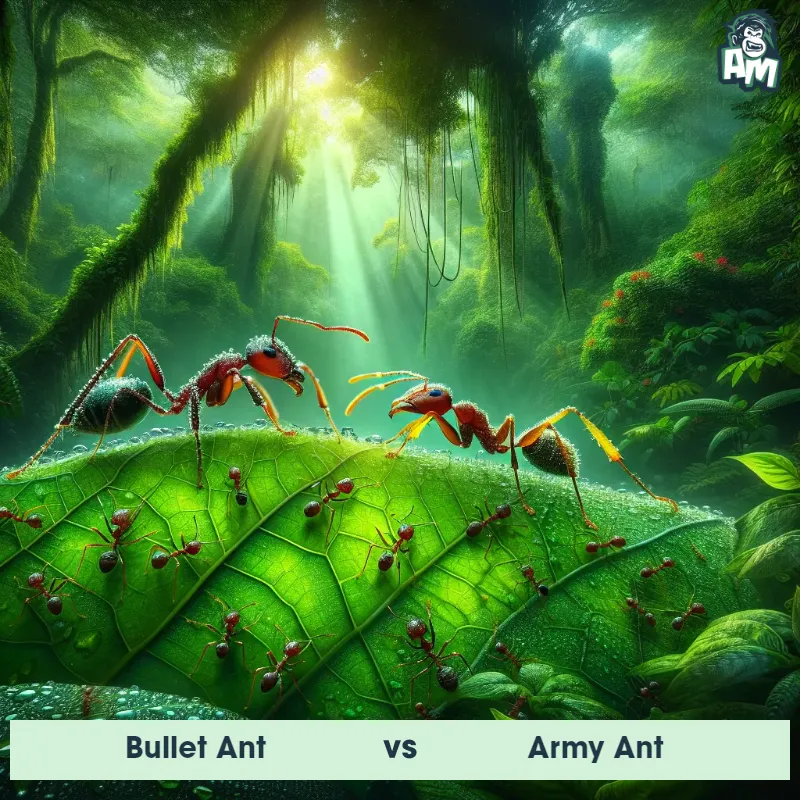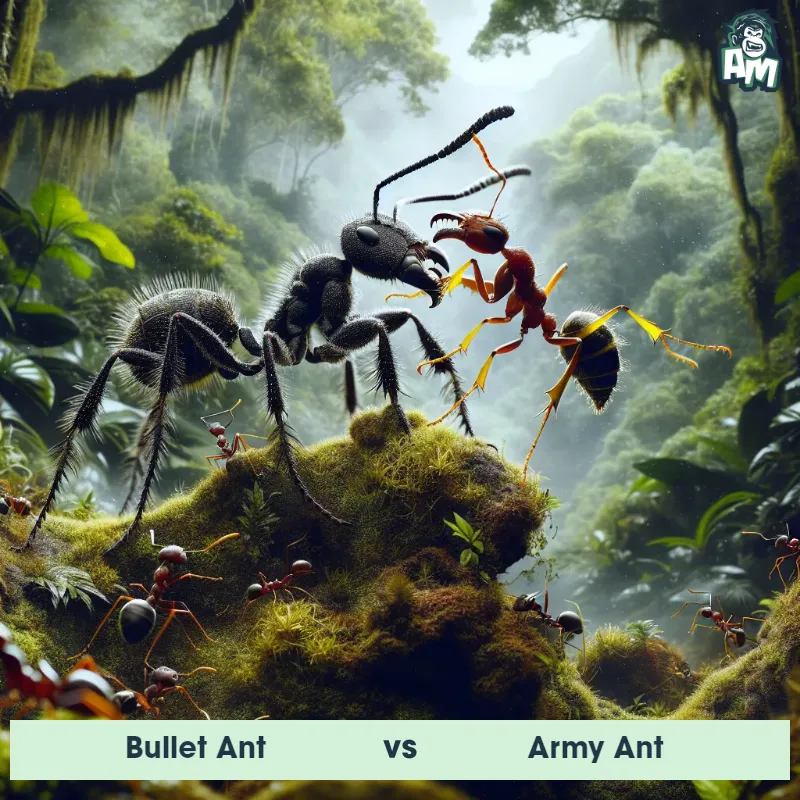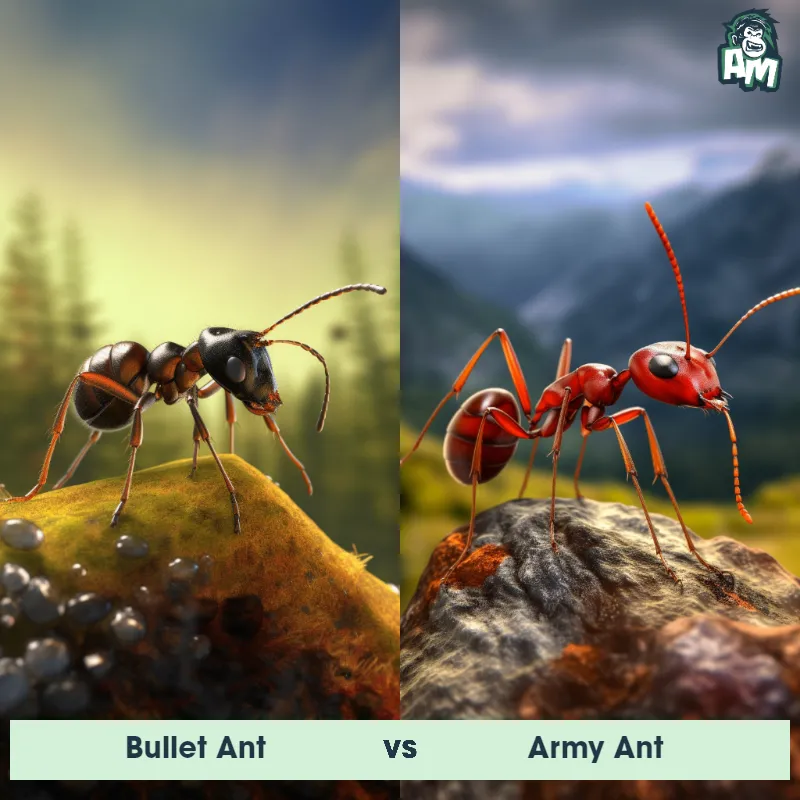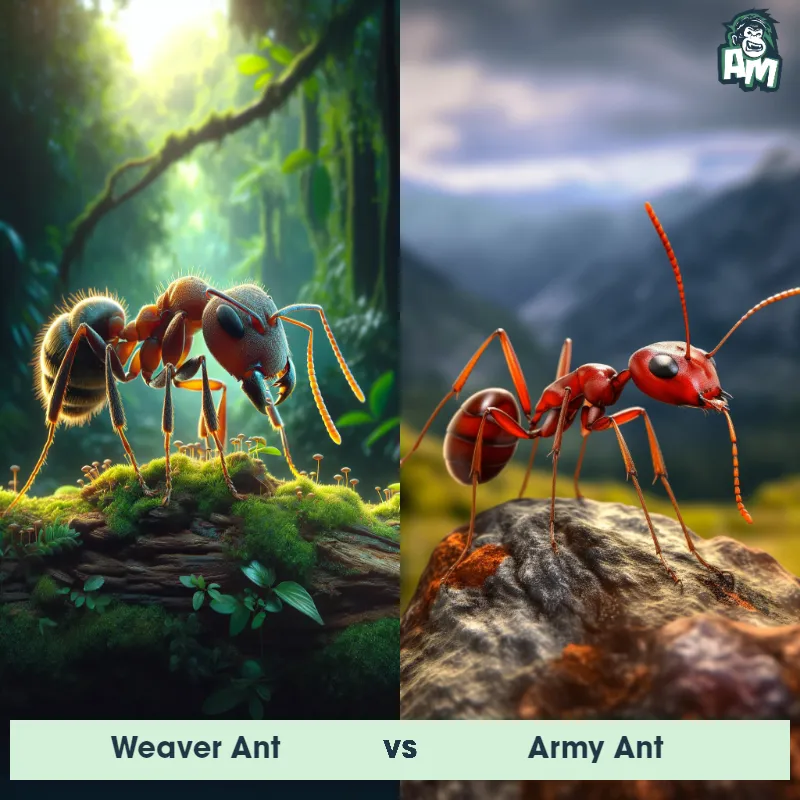The Army Ant
The Army Ant, also known as Eciton burchellii, is a species of ant known for its remarkable adaptations and intricate social structure. These ants are highly organized and exhibit swarm behavior, forming large colonies consisting of over a million individuals. Army ants are characterized by their strong mandibles, which they use to capture and dismember prey. They have a dark reddish-brown exoskeleton that helps them blend into their forested habitats. Army ants are nomadic, constantly on the move in search of food, and their colonies are constantly shifting. They are also known for their highly efficient hunting strategies and cooperative efforts, making them formidable predators in their ecosystems.

| Army Ant | |
|---|---|
| Size | Up to 1.5 cm (0.6 in) in length |
| Weight | Unknown |
| Speed | Speed: 0.000025 mph (0.04 km/hr) |
| Key Strength | Powerful mandibles for capturing prey |
| Biggest Weakness | Vulnerable to predators when not in a swarm |
| Scientific Name | Eciton burchellii |
| Family | Formicidae |
| Habitat | Forest floors and lowland rainforests |
| Geography | Central and South America |
| Diet | Insects, spiders, small vertebrates |
| Lifespan | 1 day - 3 months |

The Army Ant
The Army Ant, also known as Eciton burchellii, is a species of ant known for its remarkable adaptations and intricate social structure. These ants are highly organized and exhibit swarm behavior, forming large colonies consisting of over a million individuals. Army ants are characterized by their strong mandibles, which they use to capture and dismember prey. They have a dark reddish-brown exoskeleton that helps them blend into their forested habitats. Army ants are nomadic, constantly on the move in search of food, and their colonies are constantly shifting. They are also known for their highly efficient hunting strategies and cooperative efforts, making them formidable predators in their ecosystems.
Fun Fact: One fascinating aspect of Army Ants is their ability to construct living bridges using their own bodies to overcome obstacles. When faced with gaps or crevices, the ants link together, forming a sturdy bridge with their bodies, allowing the entire colony to cross and continue their relentless march without interruption.
| Army Ant | |
|---|---|
| Size | Up to 1.5 cm (0.6 in) in length |
| Weight | Unknown |
| Speed | Speed: 0.000025 mph (0.04 km/hr) |
| Key Strength | Powerful mandibles for capturing prey |
| Biggest Weakness | Vulnerable to predators when not in a swarm |
| Scientific Name | Eciton burchellii |
| Family | Formicidae |
| Habitat | Forest floors and lowland rainforests |
| Geography | Central and South America |
| Diet | Insects, spiders, small vertebrates |
| Lifespan | 1 day - 3 months |
Match Highlights
Army Ant Matchups
We use AI to simulate matchups between the Army Ant and other animals. Our simulation considers size, strength, and natural predatory behaviors to determine the most likely outcome.
Army Ant: Diet, Predators, Aggression, and Defensive Behaviors
What do Army Ants eat?
Army Ants are omnivorous insects that primarily feed on other insects. They are known for their marching columns, where they actively hunt for prey such as spiders, beetles, worms, and even small vertebrates. Army Ants also scavenge on dead animals and plant material when necessary.
Do Army Ants have any predators?
Yes, Army Ants have several natural predators, including birds, reptiles, amphibians, and other insects. Certain species of ants, beetles, and spiders are known to prey on Army Ant colonies. However, due to their large numbers and aggressive nature, they can often defend themselves against predators.
Are Army Ants aggressive?
Army Ants are known for their aggressive behavior, especially during their hunting expeditions. They exhibit swarm intelligence and work together to overwhelm prey. When threatened, Army Ants can quickly mobilize and attack intruders using their powerful jaws and stingers.
Do Army Ants fight?
Army Ants are highly cooperative and organized in their approach to defending their colonies. They are capable of mounting large-scale attacks on rival ant colonies or other creatures that pose a threat to their nest. Army Ant soldiers have powerful mandibles that they use in combat, and they can quickly overwhelm adversaries with sheer numbers.
How do Army Ants defend themselves?
Army Ants have developed various defense mechanisms to protect themselves and their colonies. When faced with a threat, they can swarm together to form a living barricade or ball of ants, making it difficult for predators to attack. Army Ants also release alarm pheromones to signal danger and coordinate their responses effectively.
What is the biggest weakness of Army Ants in a fight?
Despite their formidable collective strength, Army Ants have a crucial weakness in individual vulnerability. While they excel in group combat, they are susceptible to attacks that target lone individuals or small groups of ants that stray from the main column. Isolated Army Ants may be more easily picked off by predators or overwhelmed by enemies that can exploit their solitary nature.
Fun Fact: Another intriguing fact about Army Ants is their unique reproductive system, which involves a specialized caste of males called "drones." Drones have a single purpose: to mate with the queen. Once a year, during the reproductive phase known as the "nuptial flight," drones take to the skies in vast swarms, engaging in aerial battles to secure the opportunity to mate with the queen and ensure the survival of their genetic lineage.
Fun Fact: Army ants have a cooperative hunting mechanism called "raids." During a raid, thousands of ants form a moving front line, systematically flushing out and capturing prey, including insects, arachnids, and even small vertebrates. This process continues relentlessly, with the army ants exhibiting incredible coordination and teamwork to bring down their prey. The captured individuals are then carried back to the colony, where they serve as food for the entire community.



























